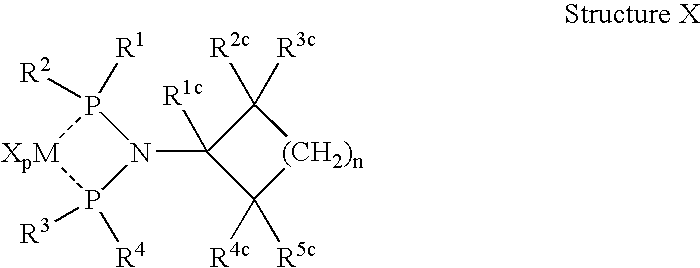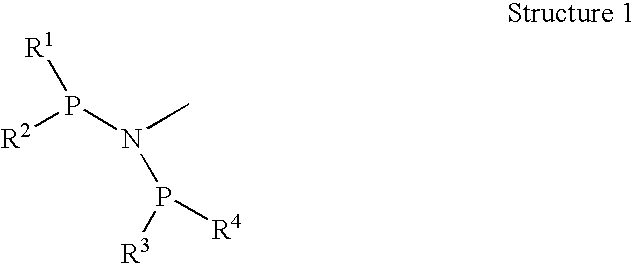Olefin oligomerization catalysts and methods of using same
a technology of oligomerization catalyst and olefin, which is applied in the field of catalyst systems, can solve the problems of low product yield and lack of selectivity to a desired product, and achieve the effect of reducing the amount of polymer produced
- Summary
- Abstract
- Description
- Claims
- Application Information
AI Technical Summary
Benefits of technology
Problems solved by technology
Method used
Image
Examples
example 1
[0214]In the example runs below, a standard solution of the ligand, typically having a concentration of approximately 10 mg / ml, was prepared by dissolving / suspending the ligand in a solvent (typically ethylbenzene). A standard solution of the chromium compound, typically having a concentration of 5 mg / ml, was prepared by dissolving / suspending the chromium compound in a solvent (typically ethylbenzene).
[0215]The catalyst was prepared by transferring the appropriate amount of ligand and chromium solutions into a thin-walled glass vial (e.g. and NMR tube). The thin-walled glass vial was tightly capped and then strapped to the impeller shaft of a Zipperclave™ reactor. The reactor was sealed and then air was removed from the reactor interior by multiple successive vacuum evacuations and charging with nitrogen. After the successive vacuum evacuations of the reactor interior, a final vacuum was left on the reactor. Under static vacuum, the reaction solvent containing the appropriate quanti...
PUM
| Property | Measurement | Unit |
|---|---|---|
| wt. % | aaaaa | aaaaa |
| wt. % | aaaaa | aaaaa |
| wt. % | aaaaa | aaaaa |
Abstract
Description
Claims
Application Information
 Login to View More
Login to View More - R&D
- Intellectual Property
- Life Sciences
- Materials
- Tech Scout
- Unparalleled Data Quality
- Higher Quality Content
- 60% Fewer Hallucinations
Browse by: Latest US Patents, China's latest patents, Technical Efficacy Thesaurus, Application Domain, Technology Topic, Popular Technical Reports.
© 2025 PatSnap. All rights reserved.Legal|Privacy policy|Modern Slavery Act Transparency Statement|Sitemap|About US| Contact US: help@patsnap.com



